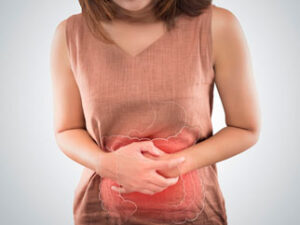UP TO 70% OF OUR IMMUNITY DEPENDS ON OUR FLORA
INTESTINAL… WHAT IF WE IMPROVE OUR DIGESTIVE TRACT TO PREVENT
diseases?
The gastrointestinal tract constitutes the second largest surface of the human body after therespiratory tract, with an approximate area of 400m2. The area of a paddle court is 200m2, a volleyball court is 162m2m2 and the international basketball court is420m2m2m2m2m2… we can realize with this the magnitude of the absorption capacity of our intestine?…
The gut microbiota is the set of microorganisms that reside in the human gut and it contains billions of microorganisms formed by bacteria, fungi, yeasts and viruses. While we have traditionally estimated that the ratio between bacteria (1014)and human cells (1013)is 10:1, the current review calculates that ratio of approximately 1:1 (3.8 x 1013 bacteria: 3 x 1013 human cells). One bacterium for every human cell.
We have the same amount of bacteria as human cells.
We are half human, half bacteria
To get an idea of the importance of this data, it is enough to say that more than 30 billion bacteria have evolved and adapted to the interior of our body, a very hostile place, where they have learned to perform vital functions for us, so much so that without them we would become seriously ill or, directly, we would die. Don't you think it makes sense to take care of them?… in short, it is to take care of our other half… today

In this graph you can see the distribution of the number and mass of the different types of cells in the human body of an adult man of 70 kg: erythrocytes or red blood cells (erythrocytes), adipocytes or fat cells (adipocytes), muscle cells (muscle cells) and others (others) and bacteria (bacteria) Revised estimates for the number of human and bacteria cells in the body.
Ron Sender, Shai Fuchs, Ron Milo. bioRxiv 036103; doi: https://doi.org/10.1101/036103 – Now published in PLOS Biology doi: 10.1371/journal.pbio.1002533 When we are in the womb, humans lack a microbiota, intestinal colonization begins in childbirth with the mother's gut and vaginal microbiota and continues with breast milk.
This is very important because in the case of cesarean deliveries colonization does not happen and must be taken into account in these children as well as when the newborn is not breastfeeding.It is known that situations that occur around birth increase the risk of developing obesity, diabetes and cardiovascular disease in adulthood, and initial colonization could be very important in determining the final composition of the permanent microbiota in adults.
The bacterial populations that will form the gut microbiota change throughout life with the environment, genetic load, age, type of diet, stress, infections, antibiotic use, food intolerances.
The interrelationship between the gut microbiota and the human host is symbiotic which means that we give it a habitat with nutrients and in return we receive functions that contribute to intestinal homeostasis (self-regulating mechanisms) both immunological and metabolic.
That is why the whole of the gut microbiota is considered as a real organ It constitutes a protective barrier against pathogens thanks to the space it occupies, the ability to secretion antimicrobial substances and the acidification of the medium by secreting organic acids.
In addition, beneficial bacteria keep epithelial cells healthy, regulating the process of constant renewal and strengthening the defense against invading microorganisms.
The gut could not digest certain nutrients from food without the help of beneficial bacteria. The intestinal microbiota intervenes in metabolic processes since they digest proteins, break down lipids and ferment the polysaccharides obtained from dietary fiber giving rise to monosaccharides and short-chain fatty acids such as acetate, propionate and butyrate. Acetate is used by myocytes and cardiomyocytes (muscle cells the former and heart muscle cells the latter), propionate is involved in hepatic gluconeogenesis (manufacture of glucose by the liver from precursors other than carbohydrates) and butyrate provides an anti-inflammatory effect and is an energy source for epithelial cells , which are the coating cells.
The dietary habits of each individual establish a profile of particular bacteria in each person. In Africa where more fiber is eaten, there is a higher proportion of bacteria called Bacteroidetes and a lower proportion of Firmicutes compared to European individuals. People who have high amounts of Firmicutes in their gut microbiota have an increased risk of diabetes, obesity and hypercholesterolemia, predisposing them to an increased risk of cardiovas-cular disease. The excessive consumption of sugary foods and processed carbohydrates favor the development of fungi, especially Candida spp.
Intestinal dysbiosis is an alteration of our microbiota, very common nowadays in the whole population; now we can understand how this generates digestive problems and diseases throughout our body.

When we have digestive symptoms that we call "chronic" such as heartburn, gas, belching, abdominal bloating, abdominal pain after meals, constipation or diarrhea among others, we have to be alert and make a proper evaluation to correct them because we will not only relieve those symptoms but we will also be improving our defenses and ensuring greater immune strength to prevent diseases of any part of our body; viral, bacterial or fungal infections, rheumatological and autoimmune diseases, metabolic diseases such as diabetes or arteriosclerosis, degenerative diseases such as Alzheimer's or pathologies such as Cancer.
If you want to evaluate your diet and lifestyle to improve your health, do not hesitate to contact for an appointment and we get to work.
Dr. Milagros Vélez Galván
Con Salud, Salut Verda
